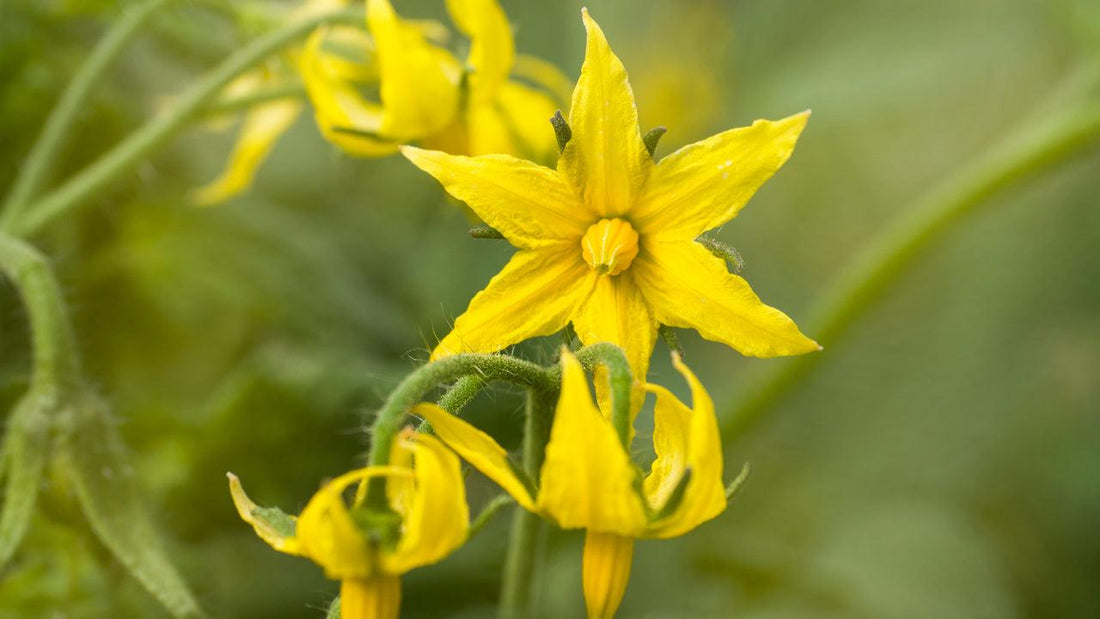Why Are Tomato Flowers Falling Off? Understanding Tomato Blossom Drop and How to Fix It
Tomatoes are among the most rewarding crops for home gardeners. With proper care, tomato plants deliver juicy fruit all season long. Yet one of the most frustrating problems in tomato growing is tomato flowers falling off before fruits can form. If you’ve ever noticed tomato blossoms falling off or tomato blooms falling off, you’re not alone. This problem—known as tomato blossom drop—can leave gardeners puzzled as their tomato plants bloom but fail to set fruit.
This guide explores why tomato plant flowers die or drop, the environmental and biological stressors behind the issue, and actionable strategies to prevent tomato blossom drop and boost fruit production.

What Is Tomato Blossom Drop?
Tomato blossom drop refers to the loss of flowers of tomato plants before pollination succeeds. A single tomato flower contains both male and female parts, meaning it can self-pollinate. But successful pollination only occurs under ideal conditions. When environmental stress, poor pollination, or nutrient imbalances interfere, tomato blossoms fall off, halting fruit development.
Learn more about the science behind this problem in Grow Organic’s guide on tomato blossoms drying up and dropping.

Environmental Stress: The Leading Cause
Extreme Temperatures
Tomatoes thrive in daytime temperatures of 70–85°F and nighttime temperatures of 55–70°F. When high temperatures exceed 90°F or drop below 55°F, pollen becomes nonviable. Heat can sterilize pollen, while cold nights hinder fertilization, both leading to tomato blooms falling off.
Consider planting heat tolerant varieties, including heirloom tomato varieties bred for hot climates.
Humidity Levels
Pollination depends heavily on humidity levels. Low humidity dries pollen, while high humidity causes clumping, preventing transfer between flower parts. Both extremes explain why tomato flowers are dying before fruit set.
Water Stress
Inconsistent watering leads to stress. Overwatering suffocates roots and may trigger blossom end rot, while underwatering wilts plants and causes flowers falling off tomato plant. Reliable irrigation methods—such as drip irrigation systems or soaker hoses for sale—maintain steady soil moisture.
Inadequate Light and Wind
Tomatoes need 6–8 hours of direct sunlight. Without enough energy for pollination and fruit set, tomato blooms are falling off. Excessive wind can also break delicate blossoms or dry them out prematurely.

Nutrient Imbalances
Nutrients drive fruit production. Too much nitrogen leads to lush foliage but poor flowering, leaving tomato plants blooming without setting fruit. A lack of phosphorus or potassium weakens flowers, making tomato blossoms fall off more likely.
Use a balanced fertilizer or consider pelleted fertilizer for steady release. Complement this with organic compost to enrich soil biology.
Biological Factors
- Pests and diseases: Thrips, aphids, and fungal diseases weaken blossoms.
- Heavy fruit set: If too many fruits form simultaneously, the plant may abort additional flowers.
- Genetics: Determinate vs. indeterminate tomato varieties differ in blooming habits. Determinate types set fruit all at once, while indeterminate types produce more flowers continuously.

Best Practices to Prevent Tomato Blossom Drop
Mulch to Regulate Soil Conditions
A 2–3 inch layer of mulch helps stabilize soil moisture and temperature, reducing stress. Explore tips in Mulch Beyond the Basics and Using Compost and Mulch Over Winter.
Provide Shade During Heatwaves
When daytime temperature exceeds 90°F for several days, tomato blossoms falling off is inevitable. Install shade cloth to protect flowers during the hottest hours.
Fertilize Smartly
Avoid overloading with nitrogen. Instead, apply a balanced fertilizer or compost for long-term soil enrichment.
Encourage Pollination
Tomatoes are self-pollinating but benefit from vibrations. Attract pollinators by planting marigolds, borage, or calendula nearby. Gently shake plants or use an electric toothbrush to mimic bee pollination.
Rotate Crops
Avoid planting tomatoes in the same spot each year. Use this vegetable crop rotation guide to reduce soil-borne diseases.
Conclusion
While tomato blossoms falling off may seem discouraging, understanding the causes helps you prevent it. From regulating humidity levels and soil moisture to planting the right tomato varieties, every step matters. By managing extreme temperatures, fertilizing wisely, and encouraging pollinators, you’ll prevent tomato blossom drop and enjoy stronger tomato plants blooming that set fruit successfully. With these practices, your tomato plants will reward you with steady fruit production and a harvest of ripe, juicy fruit.
Give your plants the nutrition they need—shop our Fertilizers & Growing Supplies.
FAQs About Tomato Blossoms Falling Off
How do you stop tomatoes from dropping blossoms?
How to prevent flower drop?
Why are my tomatoes flowering but not producing fruit?
What are the signs of overwatering tomato plants?
How can I add calcium to my tomato plants fast?
What is bloom drop?
Should I cut off dead tomato blossoms?
How to fix blossom end rot on tomatoes?
Can blossom drop be reversed?
How to boost flowering in tomatoes?
Tomato Growing Resources
For more tomato growing tips and to start your planting journey:
- Browse our Tomato Seeds Collection
- Visit the Tomato Resource Center
- Review How to Grow Tomatoes: A Growing Guide
By understanding the underlying causes of tomato flower loss and taking proactive steps to correct them, you can enjoy a thriving, fruitful tomato garden all season long.


8 comments
Is rabbit poop good for a tomato plant?
Kim, I would suggest going out at night with a flashlight and see if you can spot what is eating your blossoms. Can’t advise on an unknown pest.
I have a beautiful plant but something is gutting off blossoms help????